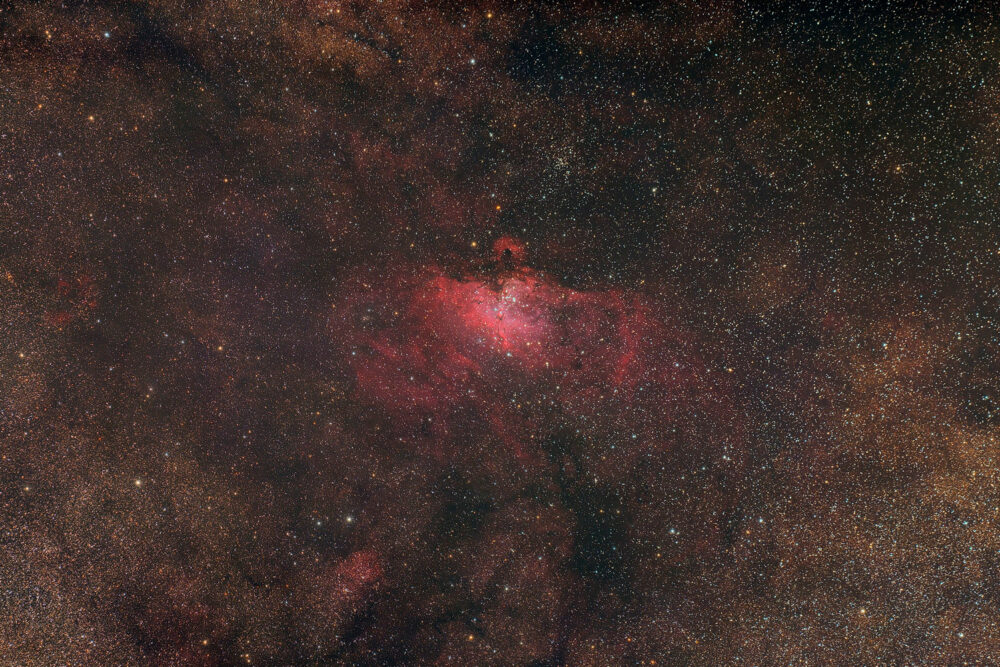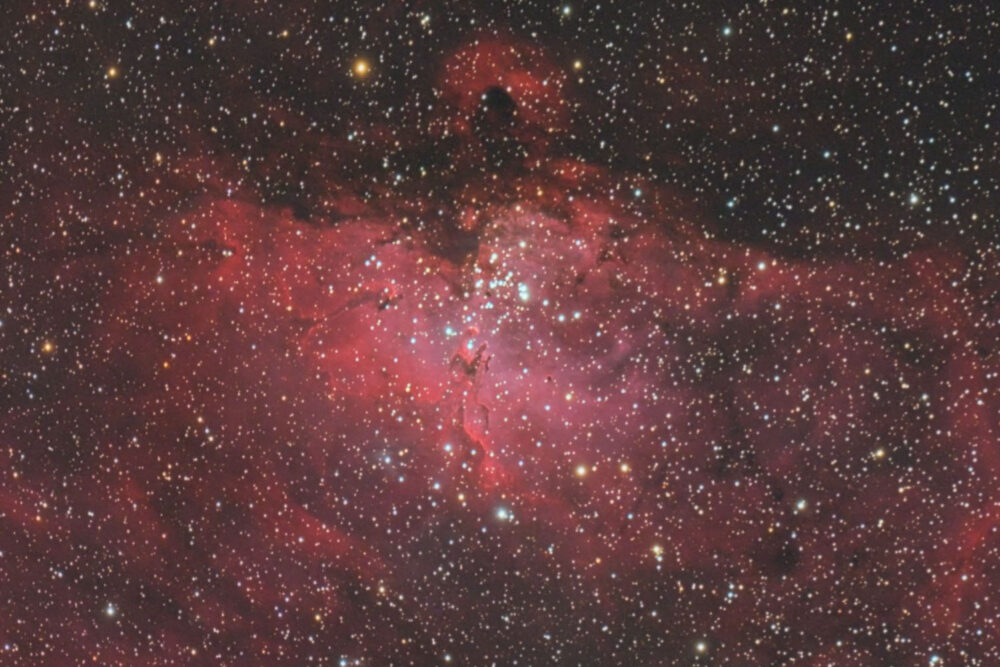Category : Nébuleuse
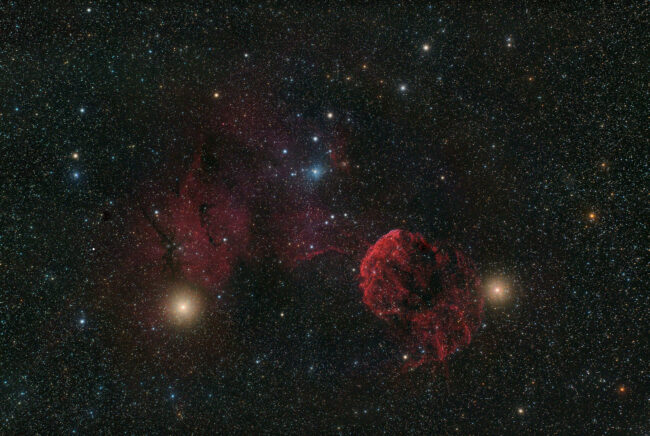
Clear and moonless sky for New Year’s Eve. I had to go out. The target was IC 443, a beautiful nebula in Gemini. A target I had already photographed in February 2023 but I didn’t remember it!
IC 443 is a supernova remnant that is believed to have exploded 30,000 – 35,000 years ago.
62 x 2 min
Camera : Nikon Z6 partially unfiltered
Telescope : Takahashi FSQ-106ED refractor.
Mount : ZWO AM5N.
Guiding : ZWO ASI290MM Mini on QHY OAG-M
Temperature : -3°C, -1°C
Humidity : 80%
SQM : 21.1
Software : acquisition with Astro Photography Tool, processing with PixInsight.
Location : Le Plan, Le Banchet
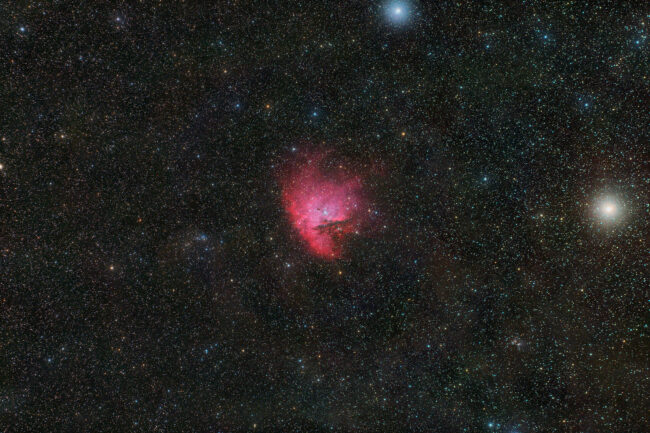
NGC 281 is a HII region, a cloud of ionized hydrogen, located in Cassiopeia. It is about 10,000 light-years from Earth with a diameter of 100 light-years. Its shape roughly resembles to Pac-Man, hence its name.
Acquired on December 28, 2024 for the production launch of my new ZWO AM5N equatorial mount which allows me to lighten the setup by 30 kg. A very appreciable weight saving in nomadic astrophotography!
54 x 2 min
Camera : Nikon Z6 partially unfiltered
Telescope : Takahashi FSQ-106ED refractor.
Mount : ZWO AM5N.
Guiding : ZWO ASI290MM Mini on QHY OAG-M
Temperature : 1°C
Humidity : 70%
SQM : 20.9
Software : acquisition with Astro Photography Tool, processing with PixInsight.
Location : Le Plan, Le Banchet
The Eagle Nebula is one of the classic summer observations near Sagittarius. It is located further north, in the constellation of the Serpens. M16 actually designates the open cluster in the center of the nebula which itself bears the designation IC 4703.
The central part became popular after the portrait made of it by the Hubble space telescope in 1995. It is a stars nursery, hence the somewhat high-sounding name as the Americans like Pillars of Creation
74 x 2 min
Camera : Nikon Z6 partially unfiltered
Telescope : Takahashi FSQ-106ED refractor.
Mount : Takahashi EM-200 homemade electronics.
Guiding : ZWO ASI290MM Mini on QHY OAG-M
Temperature : 13°C
Humidity : 70%
SQM : 21.6
Software : auto-guiding with PHD2, acquisition with Astro Photography Tool, processing with PixInsight.
Location : L’Epine
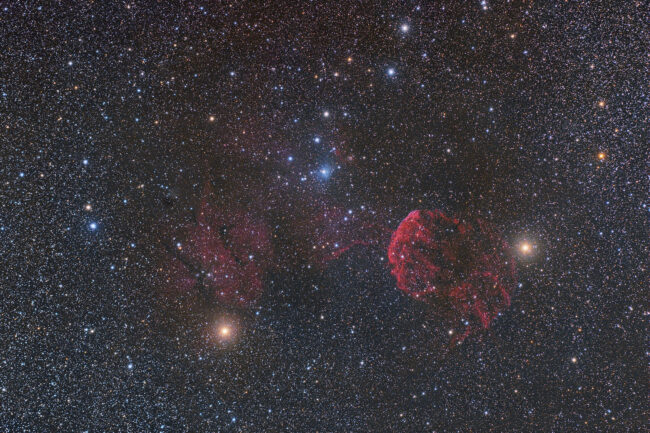
It’s a supernova remnant in the constellation Gemini. I did not know her before making the photo.
27 x 2 min
Camera : Nikon Z6 partially unfiltered
Telescope : Takahashi FSQ-106ED refractor.
Mount : Takahashi EM-200 homemade electronics.
Guiding : ZWO ASI290MM Mini on QHY OAG-M
Temperature : 3 to 1°C
Humidity : 85% to 100%
SQM : 21.2
Software : auto-guiding with PHD2, acquisition with Astro Photography Tool, processing with PixInsight.
Location : L’Epine
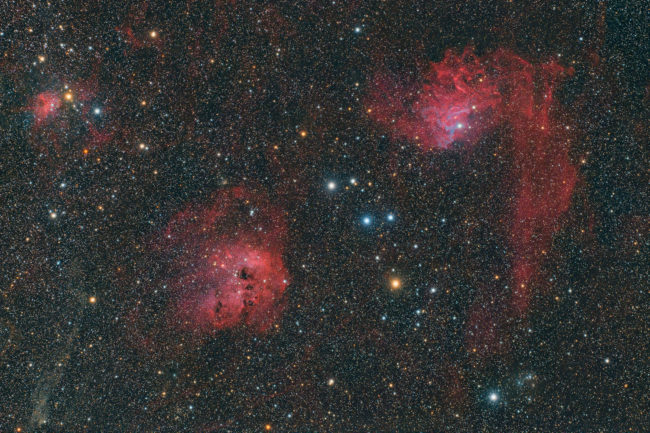
From left to right, or from smallest to largest:
– IC 417, the small Spider Nebula
– IC 410, the Tadpoles
– IC 405, the Flaming Star Nebula
Shot on December 31, 2021, about an hour before we change the year. And that’s the only deep sky image of the year, a crappy weather year.
65 x 1 min
Camera : Nikon Z6 partially unfiltered
Telescope : Takahashi FSQ-106ED refractor.
Mount : Takahashi EM-200 homemade electronics.
Temperature : 7°C
Humidity : 65%
SQM : 21.0
Software : acquisition with Astro Photography Tool, processing with PixInsight.
Location : Le Plan, Col du Banchet
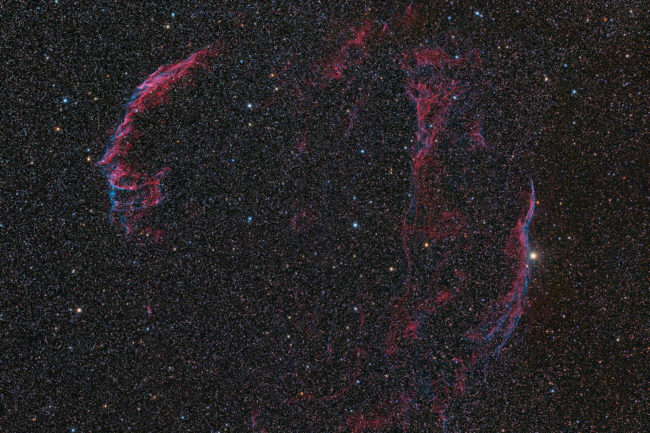
For this one, I choose to translate the french title. In english it is better known as Cygnus Loop or Veil Nebula. I thing the french name is more poetic.
The remains of a star that exploded about ten thousand years ago. We call it a supernova remnant.
It’s a great summer classic. I never miss to go to observe it visually. It is a pleasure to stroll along the filaments, from the large lace (on the left) to the small (on the right) via the Volutes of Williamina Fleming. Sometimes when the sky is really good, I can perceive other weaker part.
60 x 1 min
Camera : Nikon Z6 partially unfiltered
Telescope : Takahashi FSQ-106ED refractor.
Mount : Takahashi EM-200 homemade electronics.
Guiding : ZWO ASI290MM Mini on QHY OAG-M
Temperature : 23°C
SQM : 21
Software : auto-guiding with PHD2, acquisition with Astro Photography Tool, processing with PixInsight.
Location : Le Plan, Col du Banchet
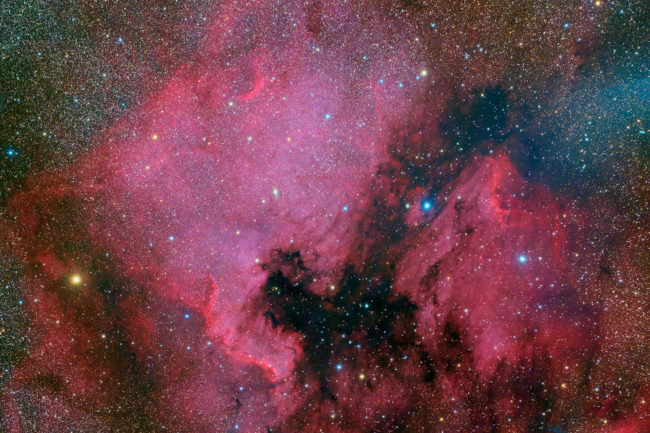
Yes, they even have their nebula… I’m not telling you where the North America Nebula is or why we call it like that, it’s pretty obvious. It’s identified as NGC 7000. To its right is the Pelican Nebula, IC 5067 and IC 5070. The bird is a little harder to recognize.
These nebulae represent only part of the H-alpha complex found in the Cygnus. Ionized hydrogen is found in a large part of the constellation and even beyond.
90 x 1 min
Camera : Nikon Z6 partially unfiltered
Telescope : Takahashi FSQ-106ED refractor.
Mount : Takahashi EM-200 homemade electronics.
Guiding : ZWO ASI290MM Mini on QHY OAG-M
Temperature : 7°C
Humidity : 84%
SQM : 21.4
Software : auto-guiding with PHD2, acquisition with Astro Photography Tool, processing with PixInsight.
Location : Le Serpaton, Gresse-en-Vercors
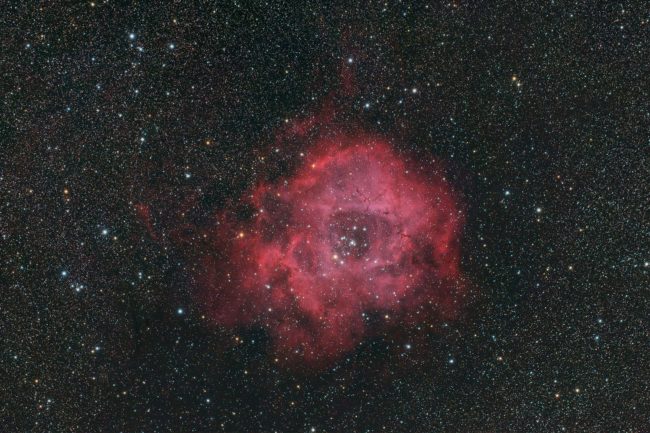
The Rosette Nebula, registred under the number Calwell 49, is an H-II region in the constellation Unicorn. As it is not a very well-known or easily identifiable constellation, so we start from Orion to locate it. It is east of Orion, in the extension of the line formed by Meissa (Lambda Orionis) and Betelgeuse. There are several entries from the NGC catalog:
- NGC 2237: the western part
- NGC 2238: another part of the nebula
- NGC 2244 (= NGC 2239): the cluster open in the center
- NGC 2246: another Rosette emission region
112 x 1 min
Camera : Nikon Z6 partially unfiltered
Telescope : Takahashi FSQ-106ED refractor.
Mount : Takahashi EM-200 homemade electronics.
Guiding : ZWO ASI290MM Mini on QHY OAG-M
Temperature : 2°C
Humidity : 68%
SQM : 21
Software : auto-guiding with PHD2, acquisition with Astro Photography Tool, processing with PixInsight.
Location : Le Plan, Col du Banchet
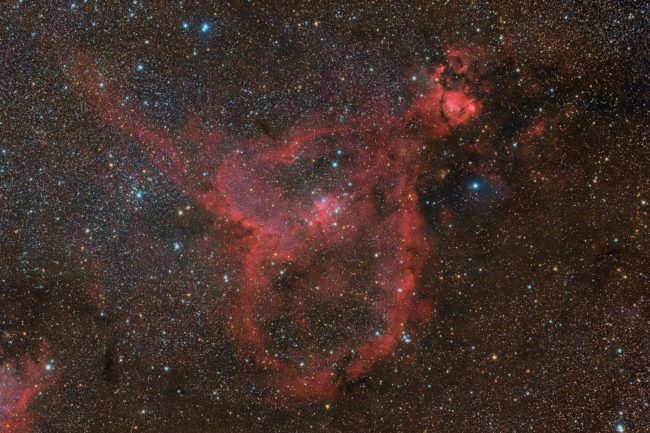
Another typical nebula of late summer. The Heart Nebula is a region HII neighbor of the Soul Nebula. In the sky, it is located in Cassiopeia, at the end of the tip of Perseus. In the galaxy, she is in the arms of Perseus, 7500 light years from us.
93 x 1min
Camera : Nikon Z6 partially unfiltered
Telescope : Takahashi FSQ-106ED refractor.
Mount : Takahashi EM-200 homemade electronics.
Guiding : ZWO ASI290MM Mini on QHY OAG-M
Temperature : 12 to 10°C
Humidity : 70% to 84%
SQM : 21.6
Software : auto-guiding with PHD2, acquisition with Astro Photography Tool, processing with PixInsight.
Location : L’Epine, Hautes-Alpes, France
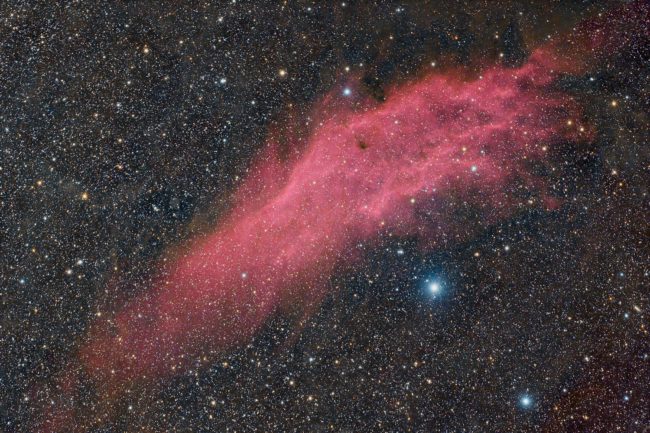
Yet another HII region, in Perseus this time. An emission nebula, therefore, the famous ionized hydrogen. Its name comes from its resemblance to the American state. It is 70 light-years long and is 1500 light-years away from us, making it the closest HII region to the solar system.
It’s not an easy to catch object since its best period for photograph it is the rainy season, the autumn, the month of November or December. I did it on September 3rd from 2am and it was still low on the horizon. So I kept only 80 of the 100 exposures I made.
80 exposures of 1 minutes
Camera : Nikon Z6 partially unfiltered
Telescope : Takahashi FSQ-106ED refractor.
Mount : Takahashi EM-200 homemade electronics.
Guiding : ZWO ASI290MM Mini on QHY OAG-M
Temperature : 8°C
Humidity : 85% to 95%
SQM : 21.6
Software : auto-guiding with PHD2, acquisition with Astro Photography Tool, processing with PixInsight.
Location : L’Epine, Hautes-Alpes, France

